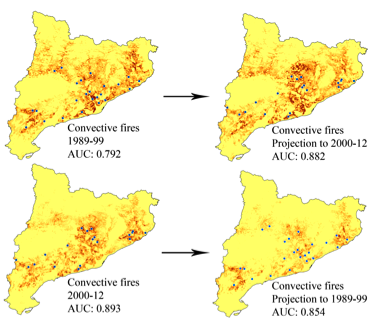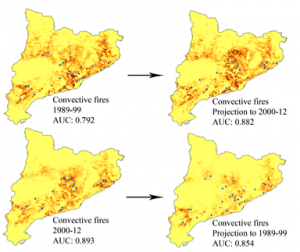New article: Predictive modelling of fire occurrences from different fire spread patterns in Mediterranean landscapes

In a new work published recently in International Journal of Wildland Fire, we present a modelling exercise for predicting different fire spread patterns in Catalonia, NE Spain.
We introduce mathematically a novel classification of fires according to dominant fire spread pattern, an approach considered in operational fire-fighting, to help understand regional-scale spatial variability in fire regimes. Dominant fire spread patterns are usually linked to specific synoptic weather conditions, topography, or vegetation patterns, determining fire behavior and thus fire suppression opportunities. More deeply, we studied whether climate, topography and fuel variables allowed the prediction of occurrences from different fire spread patterns in Catalonia, NE Spain.
We used MaxEnt to model fire occurrences of wind-driven, topography-driven and convective fires for two different time periods (1989-1999 and 2000-2012). A cross-validation between the two decades modelled was conducted, and results were consistent in all types of fire. The variation partitioning analysis showed how convective fires were more related to forest fuel factors, while wind-driven fires were mostly predicted by unmanageable factors, as topography and wind. Topography-driven fires occurred over a broader range of environments where stronger fire spread determinants such as fuel loads or strong winds were not greatly inducing the occurrence of the other fire spread patterns.
The results presented offer new insights about potential approaches allowing the assessment of environmental change impacts on different types of fire spread patterns. Changes in land-use vegetation cover or changes in forest structure are just an example of the type of events that can differentially determine the occurrence of different kinds of spread patterns. Under a global change context where the future of fire regimes still being uncertain, these findings may have a strong impact on investigations into how fire regimes may be projected into the future under forecast global change as they suggest that future environmental changes may affect different fire spread patterns in an idiosyncratic manner.






Follow up:
http://sapsque.ctfc.cat/ca/category/entrevista-ca/
http://www.ruralcat.net/web/guest/noticia/-/journal_content/2002/10136/9198268/
https://twitter.com/CREAF_ecologia/status/621630075138654208
http://www.lavanguardia.com/sucesos/20150715/54433419587/un-modelo-matematico-predice-probabilidad-de-un-paisaje-de-sufrir-un-incendio.html
This comment has been removed by the author.